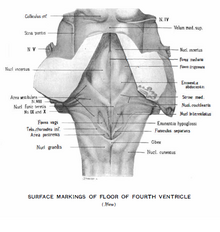
| Nucleus incertus | |
|---|---|
| Identifiers | |
| NeuroLex ID | nlx_144477 |
| Anatomical terms of neuroanatomy[edit on Wikidata] | |
The nucleus incertus is a brainstem region of the pontine brainstem, just ventral to the 4th ventricle. The term was coined by George Streeter (Latin for "uncertain nucleus") based on its unknown function at the time to name a group of cells he observed near the midline of the floor of the 4th ventricle. It sometimes called the 'nucleus O'.
The nucleus incertus is a bilateral structure which sits near the brainstem, in front of the nucleus prepositus hypoglossi. It consists of mostly ascending GABAergic projection neurons and glutamatergic neurons which innervate a broad range of forebrain regions involved in behavioural activation.
It is part of the theta network acting as a relay from the reticularis pontis oralis nucleus to the septo-hippocampal system. The stimulation of the nucleus incertus activates the hippocampal theta rhythm and either its lesion or inhibition suppress the theta oscillation induced by brainstem stimulation. The nucleus incertus itself presents theta oscillations coupled to the hippocampal theta rhythm.
In addition to hippocampal theta rhythms, the nucleus incertus is involved in the control of locomotor speed and arousal, response to stress and integrating the vestibulo-ocular reflex and gaze holding with hippocampal navigation.
Neuroanatomy and Neurochemistry
The NI consists of GABAergic and glutamatergic neurons that project widely to other regions of the brain, including the septum, hippocampus, hypothalamus, amygdala, interpeduncular nucleus and prefrontal cortex. One of the defining neurochemical characteristics of NI GABAergic neurons is their expression of relaxin-3, a neuropeptide that acts via the G-protein-coupled receptor, known as RXFP3 in various brain regions, but can also activate RXFP1. The primary effect of RXFP3 receptor activation is the suppression of neuronal activity, which occurs mainly through the opening of M-channels, allowing an outward flow of potassium ions.
The relaxin-3/RXFP3 system has been extensively studied since its discovery in 2002 due to its involvement in stress and arousal-related functions. This peptidergic system is preserved throughout vertebrate evolution and is present in zebrafish and several other species, including human. Relaxin-3 (RLN3) is detected in at least two neuronal clusters in both teleosts and mammals, in the periaqueductal grey (PAG) and the NI. However, while in the teleosts the PAG/RLN3 projections target extensive areas of the forebrain and optic tectum, the NI/RLN3 projection is concentrated in the interpeduncular nucleus. By contrast, in mammals, PAG/RLN3 projections are restricted to the brainstem and diencephalon, while NI/RLN3 projections display a wide pattern of ascending projections to areas ranging from the nearby interpeduncular nucleus to the more distant hippocampus and prefrontal cortex. In both teleosts and mammals, the RLN3 signaling system plays a central role in arousal control.
In addition to relaxin-3, NI GABAergic neurons express other neuromodulators such as cholecystokinin (CCK) and neuromedin-B (NMB). These neurons also express receptors for corticotropin-releasing factor (CRF), orexins (hypocretins), melanin- concentrating hormone (MCH), serotonin (5-HT) and glutamate; and this diverse receptor expression profile suggests that the NI integrates signals from multiple neurotransmitter systems.
References
- ^ Goto M, Swanson LW, Canteras NS (September 2001). "Connections of the nucleus incertus". The Journal of Comparative Neurology. 438 (1): 86–122. doi:10.1002/cne.1303. PMID 11503154.
- Streeter GL (1903). "Anatomy of the floor of the fourth ventricle. (The relations between the surface markings and the underlying structures.)". American Journal of Anatomy. 2 (3): 299–313. doi:10.1002/aja.1000020303. ISSN 1553-0795.
- ^ Ryan PJ, Ma S, Olucha-Bordonau FE, Gundlach AL (May 2011). "Nucleus incertus--an emerging modulatory role in arousal, stress and memory". Neuroscience and Biobehavioral Reviews. 35 (6): 1326–41. doi:10.1016/j.neubiorev.2011.02.004. PMID 21329721. S2CID 24464719.
- ^ Cheron, Guy; Ris, Laurence; Cebolla, Ana Maria (2023). "Nucleus incertus provides eye velocity and position signals to the vestibulo-ocular cerebellum: a new perspective of the brainstem–cerebellum–hippocampus network". Frontiers in Systems Neuroscience. 17. doi:10.3389/fnsys.2023.1180627. ISSN 1662-5137. PMC 10248067.
- ^ Cervera-Ferri A, Rahmani Y, Martínez-Bellver S, Teruel-Martí V, Martínez-Ricós J (May 2012). "Glutamatergic projection from the nucleus incertus to the septohippocampal system". Neuroscience Letters. 517 (2): 71–6. doi:10.1016/j.neulet.2012.04.014. PMID 22521581. S2CID 32163510.
- ^ Teruel-Martí V, Cervera-Ferri A, Nuñez A, Valverde-Navarro AA, Olucha-Bordonau FE, Ruiz-Torner A (July 2008). "Anatomical evidence for a ponto-septal pathway via the nucleus incertus in the rat". Brain Research. 1218: 87–96. doi:10.1016/j.brainres.2008.04.022. PMID 18514169. S2CID 5519042.
- ^ Nuñez A, Cervera-Ferri A, Olucha-Bordonau F, Ruiz-Torner A, Teruel V (May 2006). "Nucleus incertus contribution to hippocampal theta rhythm generation". The European Journal of Neuroscience. 23 (10): 2731–8. doi:10.1111/j.1460-9568.2006.04797.x. PMID 16817876.
- Cervera-Ferri A, Guerrero-Martínez J, Bataller-Mompeán M, Taberner-Cortes A, Martínez-Ricós J, Ruiz-Torner A, Teruel-Martí V (June 2011). "Theta synchronization between the hippocampus and the nucleus incertus in urethane-anesthetized rats". Experimental Brain Research. 211 (2): 177–92. doi:10.1007/s00221-011-2666-3. PMID 21479657. S2CID 23444954.
- ^ Lu L, Ren Y, Yu T, Liu Z, Wang S, Tan L, et al. (January 2020). "Control of locomotor speed, arousal, and hippocampal theta rhythms by the nucleus incertus". Nature Communications. 11 (1): 262. Bibcode:2020NatCo..11..262L. doi:10.1038/s41467-019-14116-y. PMC 6959274. PMID 31937768.
- Olucha-Bordonau, Francisco E.; Teruel, Vicent; Barcia-González, Jorge; Ruiz-Torner, Amparo; Valverde-Navarro, Alfonso A.; Martínez-Soriano, Francisco (2003-09-08). "Cytoarchitecture and efferent projections of the nucleus incertus of the rat". The Journal of Comparative Neurology. 464 (1): 62–97. doi:10.1002/cne.10774. ISSN 0021-9967. PMID 12866129.
- Ryan, Philip J.; Ma, Sherie; Olucha-Bordonau, Francisco E.; Gundlach, Andrew L. (2011-05-01). "Nucleus incertus—An emerging modulatory role in arousal, stress and memory". Neuroscience & Biobehavioral Reviews. 35 (6): 1326–1341. doi:10.1016/j.neubiorev.2011.02.004. ISSN 0149-7634.